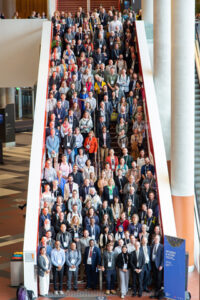Agents of change
By Maraika vanWessem
To the public, our botanic gardens are places of solace, learning and socialising. But what about the bigger picture? More than two thirds of our global population will be living in cities by 2050, yet the trees that shade and make those cities liveable are under increasing threat. Can botanic gardens benefit the world, make positive change and find solutions?

The 7th Global Botanic Gardens Congress (7GBGC) was hosted in Melbourne at Royal Botanic Gardens Victoria recently.
Delegates attended workshops, panel discussions, symposia and presentations by multiple speakers and they discussed, debated and dissected the central theme of “Influence and Action: Botanic Gardens as agents of change”.
The congress aimed to explore how botanic gardens can play a greater role in shaping our future and provoke us to look at the impact of our work.
We sat down with Professor Tim Entwisle, Director & Chief Executive, Royal Botanic Gardens Victoria to ask him for his thoughts on how botanic gardens can become agents of change.
The 7th Global Botanic Gardens Congress was a thought-provoking and life changing conference, after the uncertainties of the last few years. What makes Royal Botanic Gardens Victoria a great host organisation?
We are certainly delighted the congress was held here, in person, and at a time when botanic gardens are more important than ever.
I do think our gardens are two of the most beautiful and important in the world. Not just their stunning landscapes, but the science, the horticulture, the cultural programs and more.
The way we combine nature, science and culture, is what makes Royal Botanic Gardens Victoria one of the world’s great botanic gardens.
Why did you choose the congress theme. “Influence and Action: Botanic Gardens as Agents of change?

It’s a very deliberate statement, and one that I believe in very strongly. Together the botanic gardens of the world can have a major influence on behaviours and action, and we are very much agents of change.
That includes our leadership in climate action, our support for the greening of cities, through to providing places of solace and healing for people in a post-pandemic world.
Our botanic gardens are where many people first connect with nature and learn about the natural world. They are also the places where we experiment and learn about which trees and other plants will tolerate those changes and encourage visitors to change their behaviours and take action for climate change.
Across all our botanic gardens and arboreta, we connect with perhaps a billion visitors each year, in our landscapes and increasingly through our social media and online presence. Here in Royal Botanic Gardens Victoria, we have over two million visitors each year to our two botanic gardens – Melbourne and Cranbourne.
We must be catalysts for change and advocates for wise decision making and action. We must take action ourselves to respond to climate change.
At our best we combine innovative science, excellence in horticulture, the very best public programming and that sheer beauty and wonder of our finely curated collections of living plants, to change the world.
The congress was our chance to learn from others to do this, even better, to influence and to act for the health of this planet, and its people and plants.
What does the role of public gardens have in environmental, pandemic and economic recovery?
The pandemic demanded a coordinated response from all of us and we must continue to work together and be adaptive and agile in face of the next challenge.
New ways to think about engagement and education, new tools for managing complex horticultural landscapes, innovations and new ways of adapting as organisations to improve our social value and impact, and much more.
Bushfire, flood, drought and extreme weather have been prominent features of life in the southern hemisphere in recent years. If this continues, will many plant species struggle to survive and what is already being done to help?
The state of Victoria is home to some amazing and important plants and animals. As elsewhere, our biodiversity is fragile with climate change and land clearing are major threats to its survival.
As a result, Royal Botanic Gardens Victoria has responded through our Plant Rescue and Care Unit, a wide range of programs focussed on collecting and storing plant material, genomic and conservation genetics research, and management of landscapes in cities and beyond.

A key focus for the congress was climate resilience and action – changing behaviours, but also adapting landscapes to the already changed environment. How has Royal Botanic Gardens Victoria undertaken these types of changes?
Our gardens are also ‘on Country’, as we say in Australia, and we must collaborate and learn from traditional custodian’s knowledge systems and frameworks. At the Global Conversations presentation of the congress, our team spoke about how this traditional knowledge can be used to help our gardens become more climate resilient.
In our Melbourne and Cranbourne Gardens we’ve been working with traditional owners and the Global Indigenous Design Charter to review and redesign our wayfinding and interpretation, to be rolled out over coming months. We are proud of this work and believe it’s global best practice.
What can gardens do to mitigate the effects of climate change?
Climate change was a reoccurring theme at the congress, as it should be. In 2018 we established the Climate Change Alliance of Botanic Gardens here in Melbourne and Cranbourne, a group that now includes over 500 members.
At the congress we launched the the Landscape Succession Toolkit and the Climate Assessment Tool to help botanic gardens, and soon others, to manage their collections and landscapes in the face of climate change.
What is the climate assessment tool and toolkit and how will it help gardens and how will it help garden and landscape managers?
These tools were developed to help garden and landscape managers select plants that will thrive in future climates. While we must continue to halt human-induced global warming, our garden and park landscapes will need to adapt the already changed climate.
Both tools have evolved from the Landscape Succession Strategy released by Royal Botanic Gardens Victoria in 2016, the first of its kind for botanic gardens in Australia and a blueprint for other botanic gardens across the world. The strategy guides the selection of trees and plants at Royal Botanic Gardens Melbourne, to those more suited to the projected climate of 2090, which is predicted to be more like present day Dubbo.

The Landscape Succession Toolkit provides a framework for botanic gardens to develop their own landscape succession strategies, while allowing botanic gardens the flexibility to discover creative solutions to their own unique challenges and opportunities. This Toolkit is made possible thanks to generous support from Botanic Gardens Australia & New Zealand (BGANZ).
The Climate Assessment Tool takes this a step further. It compares natural and cultivated records of over 60,000 trees and compares them to climate data projected in the Intergovernmental Panel on Climate Change (IPCC) emission scenarios. This gives botanic gardens guidance on which trees may struggle or thrive in their future climate, and a direction for research and experimentation.
This online assessment tool was developed by the Climate Change Alliance of Botanic Gardens, Botanic Gardens Conservation International, International Association of Botanic Gardens, Royal Botanic Gardens Victoria and the University of Tasmania.
The Landscape Succession Strategy Toolkit is available for free download from the Royal Botanic Gardens Victoria website and the Climate Assessment Tool will be freely available in the first instance to all botanic gardens.
Why is it important we change our behaviours now?
The world’s botanic gardens hold vast resources of horticultural and scientific knowledge, and this is our opportunity to apply that to one of the greatest challenges to face our planet. Botanic garden landscapes and their plant collections are too important for science, conservation and changing behaviours to not act now.
Recently the news reported that two-thirds of the tree species growing in the world’s cities will be at risk of dying by 2050. Is that true, and what can be done to prevent this?
Yes, in Melbourne and Sydney that number is above 90%. In places like Barcelona, New Delhi and Singapore, all trees are at risk.
The Climate Assessment Tool will provide the information land managers select from 60,000 tree species to plant for a future climate in their city.
The Landscape Succession Toolkit helps botanic gardens to prepare a plan like we did for Melbourne Gardens in 2016, to adapt your garden to a changed climate.
Let’s strengthen the role of botanic gardens as change agents, in the cities in which we are based, and outside those cities to the lands and waters we need to care for if we want this planet and its people to survive and thrive.
For further information, please visit:
Landscape Succession Toolkit | Royal Botanic Gardens Victoria (rbg.vic.gov.au)
Maraika vanWessem
Communications, Marketing & Media Lead
T +61 3 9252 2393, M +61 497 200 989
Maraika.vanWessem@rbg.vic.gov.au
Main Photo: The Global Botanic Gardens congress was well attended

